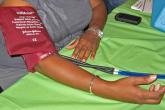News

Mitchel L. Zoler, Family Practice News Digital Network
AT THE AHA SCIENTIFIC SESSIONS
ORLANDO – The paradigm-shifting results from the SPRINT trial showed the added benefit from a new target systolic blood-pressure goal of less than 120 mm Hg for many patients with risk factors for cardiovascular disease, but the results did not address the issue of which systolic blood pressure to use to identify patients who have hypertension and require drug intervention.
“We tested a target of less than 120 mm Hg against a target of less than 140 mm Hg; the question of whom to treat and to whom this applies” did not get tested in SPRINT (Systolic Blood Pressure Intervention Trial), Dr. Jackson T. Wright Jr. said in an interview at the American Heart Association scientific sessions.
“What the trial showed was that treating to a systolic blood pressure of less than 120 mm Hg reduced the primary, combined endpoint by [a relative] 25%, reduced all-cause mortality by [a relative] 27%, and reduced heart failure by [a relative] 38%” compared with patients treated to a target systolic pressure of less than 140 mm Hg, said Dr. Wright, professor and director of the clinical hypertension program at University Hospitals Case Medical Center in Cleveland. Concurrently with the study’s report, the SPRINT results appeared in an article published online (N Engl J Med. 2015;doi:10.1056/NEJMoa1511939).
Dr. Wright acknowledged that the more aggressive antihypertensive regimen used in SPRINT to get patients’ systolic blood pressure to a goal of less than 120 mm Hg resulted in an absolute 2.2% increased rate of serious adverse events attributable to study treatment compared with the control patients treated to a target pressure of less than 140 mm Hg, but he contended that the benefits from lower pressure outweighed this risk. Patients in the more aggressive arm required an average of 2.8 drugs/patient compared with an average of 1.8 antihypertensive drugs used by control patients. The average achieved systolic blood pressure in the aggressive arm was 121.5 mm Hg, and 134.6 mm Hg in the control arm.
Patients enrolled in SPRINT had to be at least 50 years old, have a systolic blood pressure of 130-180 mm Hg, and have an increased risk for cardiovascular disease events. That risk was defined as having at least one of these factors: clinical or subclinical cardiovascular disease other than stroke; chronic kidney disease (but excluding polycystic kidney disease) with an estimated glomerular filtration rate of 20-59 mL/min per 1.73 m2; a 10-year cardiovascular disease risk of at least 15% based on the Framingham risk score; or an age of 75 years or older. The study excluded patients with a history of stroke or diabetes.
Subgroup analyses showed consistent benefit across all subgroups including age, gender, race, the presence or absence of chronic kidney disease, and systolic blood pressure at entry. A third of patients entered the trial with a systolic blood pressure of 132 mm Hg or less. Also at baseline, 91% of enrolled patients had already been receiving antihypertensive drugs. Overall, enrolled patients were receiving an average of 1.8 antihypertensive drugs each when they entered the study.
Patients enrolled in SPRINT received treatment for an average of 3.26 years. The investigators had designed SPRINT to run for 5 years but stopped the trial sooner than planned in August when the study’s data and safety monitoring board identified clear evidence of the superiority of the more aggressive treatment that fulfilled the trials prespecified stopping criterion.
SPRINT received no commercial funding. The study received antihypertensive drugs from Arbor and Takeda at no charge for a small percentage of enrolled patients. Dr. Wright had no disclosures.


